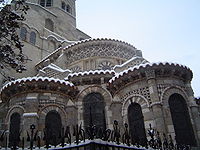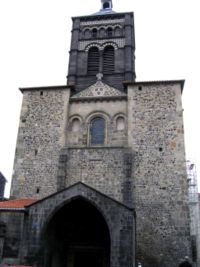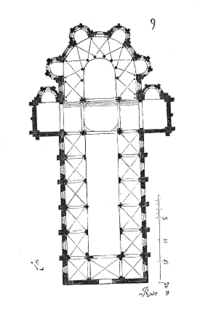
Notre-Dame du Port
Encyclopedia

Romanesque architecture
Romanesque architecture is an architectural style of Medieval Europe characterised by semi-circular arches. There is no consensus for the beginning date of the Romanesque architecture, with proposals ranging from the 6th to the 10th century. It developed in the 12th century into the Gothic style,...
basilica, formerly a collegiate church
Collegiate church
In Christianity, a collegiate church is a church where the daily office of worship is maintained by a college of canons; a non-monastic, or "secular" community of clergy, organised as a self-governing corporate body, which may be presided over by a dean or provost...
, in the Port quarter of Clermont-Ferrand
Clermont-Ferrand
Clermont-Ferrand is a city and commune of France, in the Auvergne region, with a population of 140,700 . Its metropolitan area had 409,558 inhabitants at the 1999 census. It is the prefecture of the Puy-de-Dôme department...
, between Place Delille and the cathedral. From the 10th century to the French Revolution
French Revolution
The French Revolution , sometimes distinguished as the 'Great French Revolution' , was a period of radical social and political upheaval in France and Europe. The absolute monarchy that had ruled France for centuries collapsed in three years...
it was served by a community of canons
Canon (priest)
A canon is a priest or minister who is a member of certain bodies of the Christian clergy subject to an ecclesiastical rule ....
, regular
Canons Regular
Canons Regular are members of certain bodies of Canons living in community under the Augustinian Rule , and sharing their property in common...
until the 13th century, and thereafter secular.
History


Normans
The Normans were the people who gave their name to Normandy, a region in northern France. They were descended from Norse Viking conquerors of the territory and the native population of Frankish and Gallo-Roman stock...
. The establishment here of a community of canons took place no earlier than the middle of the 10th century, under bishop Étienne II of Clermont.
The church was formally declared a basilica minor on 3 May 1886.
In the 19th century the bell tower
Bell tower
A bell tower is a tower which contains one or more bells, or which is designed to hold bells, even if it has none. In the European tradition, such a tower most commonly serves as part of a church and contains church bells. When attached to a city hall or other civic building, especially in...
was added, and the Romanesque roof tiles were replaced by lava slabs. These have since been removed again and the roof restored as near as possible to its original state. A major restoration programme took place in the church interior between 2007 and 2008, consisting of the cleaning of all the stonework, the removal of cement pointing from the restoration of the 19th century, the restoratin of the pictures and the replacement of the lustres (the crypt however was not included).
On Sunday 7 December 2008 the statue of Notre-Dame du Port ("Our Lady of the Port") was reinstalled in the church, having been kept safe in Clermont Cathedral during the restoration works, thus marking the reopening of the building to the public.
In 1998 the Basilica of Notre-Dame du Port was added to the UNESCO
UNESCO
The United Nations Educational, Scientific and Cultural Organization is a specialized agency of the United Nations...
World Heritage list as part of the Routes of Santiago de Compostela in France
World Heritage Sites of the Routes of Santiago de Compostela in France
In 1998, several sites in France were added to the UNESCO World Heritage Sites under the description: Routes of Santiago de Compostela in France....
.
The name "du Port" supposedly comes from the fact that the church was built in the "port" district, in Latin
Latin
Latin is an Italic language originally spoken in Latium and Ancient Rome. It, along with most European languages, is a descendant of the ancient Proto-Indo-European language. Although it is considered a dead language, a number of scholars and members of the Christian clergy speak it fluently, and...
portus, here in the sense of "market" rather than "seaport". It should be noted however that the church at first bore the name of Sainte-Marie-Principale; the description Portus or du Port is not known before the 11th century. Nor was the Port district, at least in the Middle Ages, a particularly commercial one: the districts of Saint-Pierre and Saint-Genès were much more so.
Description

Auvergne (province)
Auvergne was a historic province in south central France. It was originally the feudal domain of the Counts of Auvergne. It is now the geographical and cultural area that corresponds to the former province....
known as the "greater" churches (majeures), the others being the church of Saint-Austremoine in Issoire
Issoire
Issoire is a commune in the Puy-de-Dôme department in Auvergne in central France.-Geography:Issoire is located on the Couze River, near its junction with the Allier, SSE of Clermont-Ferrand on the Paris-Lyon-Méditerranée railway to Nîmes...
, the Basilica of Notre-Dame of Orcival
Orcival
Orcival is a commune in the Puy-de-Dôme department in Auvergne in central France.-References:*...
, the church of Saint-Nectaire
Saint-Nectaire
Saint-Nectaire is a French cheese made in the Auvergne region of central France. The cheese has been made in Auvergne since at least the 17th century. Its name comes from the Marshal of Senneterre , who served it at the table of Louis XIV...
, and the church of Saint-Saturnin
Saint-Saturnin, Puy-de-Dôme
Saint-Saturnin is a commune in the Puy-de-Dôme department in Auvergne in central France.-References:*...
.
Built of arkose
Arkose
Arkose is a detrital sedimentary rock, specifically a type of sandstone containing at least 25% feldspar. Arkosic sand is sand that is similarly rich in feldspar, and thus the potential precursor of arkose....
, a sort of sandstone
Sandstone
Sandstone is a sedimentary rock composed mainly of sand-sized minerals or rock grains.Most sandstone is composed of quartz and/or feldspar because these are the most common minerals in the Earth's crust. Like sand, sandstone may be any colour, but the most common colours are tan, brown, yellow,...
, the building has an almost perfect harmony supposedly resulting from the application of the ratio of the Golden Number
Golden ratio
In mathematics and the arts, two quantities are in the golden ratio if the ratio of the sum of the quantities to the larger quantity is equal to the ratio of the larger quantity to the smaller one. The golden ratio is an irrational mathematical constant, approximately 1.61803398874989...
.
The church is built on a Latin cross ground plan with a nave of six bays between two low side aisles with simple vaults. There is a transept
Transept
For the periodical go to The Transept.A transept is a transverse section, of any building, which lies across the main body of the building. In Christian churches, a transept is an area set crosswise to the nave in a cruciform building in Romanesque and Gothic Christian church architecture...
with a semi-circular chapel on each arm, and a quire surrounded by an ambulatory
Ambulatory
The ambulatory is the covered passage around a cloister. The term is sometimes applied to the procession way around the east end of a cathedral or large church and behind the high altar....
from which open four radiating chapel, none of them on the main axis, thus forming a chevet, which with its fine mosaics is a notable example of the Romanesque art of Auvergne. The capital
Capital (architecture)
In architecture the capital forms the topmost member of a column . It mediates between the column and the load thrusting down upon it, broadening the area of the column's supporting surface...
s, which are among the finest in Auvergne, principally depict scenes from the Bible, but also some from the Psychomachia
Psychomachia
The Psychomachia by the Late Antique Latin poet Prudentius is probably the first and most influential "pure" medieval allegory, the first in a long tradition of works as diverse as the Romance of the Rose, Everyman, and Piers Plowman.In slightly less than a thousand lines, the poem describes the...
of Prudentius
Prudentius
Aurelius Prudentius Clemens was a Roman Christian poet, born in the Roman province of Tarraconensis in 348. He probably died in Spain, as well, some time after 405, possibly around 413...
.

